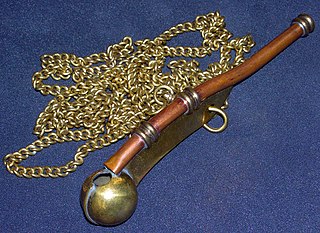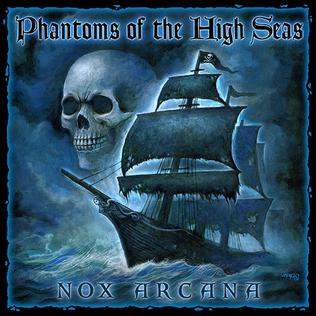
K-19 was the first submarine of the Project 658 class, the first generation of Soviet nuclear submarines equipped with nuclear ballistic missiles, specifically the R-13 SLBM. The boat was hastily built by the Soviets in response to United States' developments in nuclear submarines as part of the arms race. Before she was launched, 10 civilian workers and a sailor died due to accidents and fires. After K-19 was commissioned, the boat had multiple breakdowns and accidents, several of which threatened to sink the submarine.

A kobold is a mythical sprite. Having spread into Europe with various spellings including "goblin" and "hobgoblin", and later taking root and stemming from Germanic mythology, the concept survived into modern times in German folklore.

The Sea-Wolf is a 1904 psychological adventure novel by American writer Jack London. The book's protagonist, Humphrey Van Weyden, is a literary critic who is a survivor of an ocean collision and who comes under the dominance of Wolf Larsen, the powerful and amoral sea captain who rescues him. Its first printing of forty thousand copies was immediately sold out before publication on the strength of London's previous The Call of the Wild. Ambrose Bierce wrote, "The great thing—and it is among the greatest of things—is that tremendous creation, Wolf Larsen... the hewing out and setting up of such a figure is enough for a man to do in one lifetime... The love element, with its absurd suppressions, and impossible proprieties, is awful."

Caulk or, less frequently, caulking is a material used to seal joints or seams against leakage in various structures and piping.

The Flying Dutchman is a legendary ghost ship, allegedly never able to make port, but doomed to sail the seven seas forever. The myth is likely to have originated from the 17th-century Golden Age of the Dutch East India Company (VOC) and of Dutch maritime power. The oldest known extant version of the legend dates from the late 18th century. According to the legend, if hailed by another ship, the crew of the Flying Dutchman might try to send messages to land, or to people long dead. Reported sightings in the 19th and 20th centuries claimed that the ship glowed with a ghostly light. In ocean lore, the sight of this phantom ship functions as a portent of doom. It was commonly believed that the Flying Dutchman was a Fluyt.

Essex was an American whaling ship from Nantucket, Massachusetts, which was launched in 1799. In 1820, while at sea in the southern Pacific Ocean under the command of Captain George Pollard Jr., the ship was attacked and sunk by a sperm whale. Thousands of miles from the coast of South America with little food and water, the 20-man crew was forced to make for land in the ship's surviving whaleboats.

The Enemy Below is a 1957 DeLuxe Color war film in CinemaScope about a battle between an American destroyer escort and a German U-boat during World War II. Produced and directed by Dick Powell, the movie stars Robert Mitchum and Curt Jürgens as the American and German commanding officers. The film was based on the 1956 novel by Denys Rayner, a British naval officer involved in anti-submarine warfare throughout the Battle of the Atlantic.

A boatswain's call, pipe or bosun's whistle is a pipe or a non-diaphragm type whistle used on naval ships by a boatswain.

A jukung or kano, also known as cadik is a small wooden Indonesian outrigger canoe. It is a traditional fishing boat, but newer uses include "Jukung Dives", using the boat as a vehicle for small groups of SCUBA divers.

Morgenrot is a 1933 German submarine film set during World War I.
Captain Alfred Bulltop Stormalong was an American folk hero and the subject of numerous nautical-themed tall tales originating in Massachusetts. Stormalong was said to be a sailor and a giant, some 30 feet (9.1 m) tall; he was the master of a huge clipper ship known in various sources as either the Courser or the Tuscarora, a ship purportedly so tall that it had hinged masts to avoid catching on the Moon.

Booby Island is located 45 km (28 mi) northwest of Muttee Heads at the tip of Cape York Peninsula in Queensland, Australia. This island is in the Torres Strait, 32 km (20 mi) west of Thursday Island and 23 km (14 mi) west of Prince of Wales Island. Booby Island is also known as Ngiangu by the Kuarareg people of the western Torres Strait, its traditional owners, named for the giant Ngiangu who was forced from a neighbouring island It has been called Booby Island by a number of European explorers, including Captain Cook, for the presence of the booby birds.

The Boats of the "Glen Carrig" is a horror novel by English writer William Hope Hodgson, first published in 1907. Its importance was recognised in its later revival in paperback by Ballantine Books as the twenty-fifth volume of the celebrated Ballantine Adult Fantasy series in February 1971.
The Sailor's Hornpipe is a traditional hornpipe melody and linked dance with origins in the Royal Navy.
Caesar, later known as “Black Caesar”, was a pirate who operated during the Golden Age of Piracy. He served aboard the Queen Anne's Revenge of Edward Teach (Blackbeard) and was one of the surviving members of that crew following Blackbeard’s death at the hands of Lieutenant Robert Maynard in 1718. Myths surrounding his life - that he was African royalty and terrorized the Florida Keys for years before joining Blackbeard - have been intermixed with legends and fictional accounts as well as with other pirates.

Phantoms of the High Seas is the tenth album by dark ambient duo Nox Arcana. The theme of the album is pirate lore and stories of ghost ships. Instrumentation includes deep bass horns, pounding drums, string instruments, and narration by Joseph Vargo telling the tale of a doomed pirate vessel called The Tempest. The instrumentals are accompanied by sound effects that include a howling wind and the snap of sails, the sound of creaking as of a wooden boat left derelict at sea, an eerie yet alluring chorus like that of a siren calling sailors to their doom, male voices of the ship's crew as they call out to the beat of a dirge while rowing, and thunderous sounds of cannon fire.
Sailors' superstitions are superstitions particular to sailors or mariners, and which traditionally have been common around the world. Some of these beliefs are popular superstitions, while others are actually better described as traditions, stories, folklore, tropes, myths, or legend.

The blue men of the Minch, also known as storm kelpies, are mythological creatures inhabiting the stretch of water between the northern Outer Hebrides and mainland Scotland, looking for sailors to drown and stricken boats to sink. They appear to be localised to the Minch and surrounding areas to the north and as far east as Wick, unknown in other parts of Scotland and without counterparts in the rest of the world.
This is a glossary of nautical terms; an alphabetical listing of terms and expressions connected with ships, shipping, seamanship and navigation on water, but not necessarily on the sea. Some remain current, while many date from the 17th to 19th centuries. The word nautical derives from the Latin nauticus, from Greek nautikos, from nautēs: sailor, from naus: ship.














